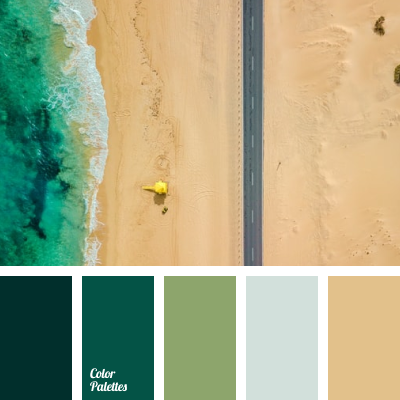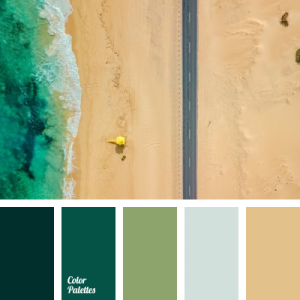
A nature-inspired color palette from colorpalette.net
Biophilic Design is Going Mainstream
For anyone who’s been following our work, you know that biophilic design isn’t just our business, it’s our passion. Literally. It means a love of nature, and in design it’s a way to bring natural elements indoors. That can mean living walls, moss walls, and adding other natural elements to the built environment, like house plants / indoor plants, just for starters. Countless studies have shown that biophilic design isn’t just nice to look at, but also improves emotional wellness, reduces stress, boosts creativity and even helps filter air, reducing volatile organic compounds and adding oxygen.
As biophilic design continues to grow from plant-lover’s niche to expansive TikTok trend (20.9 million views!), the ways we think about it and incorporate nature into homes and offices is expanding, too. If you’ve been in your local craft store lately, you’ve seen some obvious biophilic design trends. In addition to the replica and silk plants, you’ve seen rolls of faux moss and greenery spilling out of the shelves to help with a DIY approach to biophilic design.
As we dive full steam into the new year, here are some of the trends taking shape in homes to offices and beyond in 2023.
1. Richer, Darker Greens
When biophilic design started to make its way into the mainstream, bright greens and lime tones were often the go-to colors to get the plant vibes rolling. Yes, green is a universally nature-like color in every shade. But as the biophilic design trend matures, so are tastes. In 2023, designers are seeing a shift to richer, darker tones. Think forest green, emerald green and other related, richer shades—sometimes even with undertones of blues and teals. Source: Bedthreads
2. Lived-in Vibes
Here in Southern California clean, airy and coastal design transcends trends. But in 2023, we’ll see more unique pieces, heirlooms and thrifted pieces that have personal meaning to people. There might still be a lot of white space and neutral-tone shelves, but they’ll be adorned with funky finds or second-hand treasures. People are reaching for things that bring a warm, homey feel to their space with sustainability and/or re-use in mind. For the first time in 30+ years, antiques are trendy. Source: Bedthreads
3. More Greenery (but not too much)
“If you want to spruce up your space, try adding some potted plants or hanging vines throughout your kitchen and living space,” say the experts at 21 Oak. (Yeah, we knew that. But reminders never hurt!) That can mean experimenting with hanging plants in places like the bathroom or kitchen—rooms that don’t always benefit from biophilic design. But like any design idea, don’t go overboard. We make careful choices when it comes to bringing in more plants; mix and match and play with placement. Too much will undermine the calming effect.
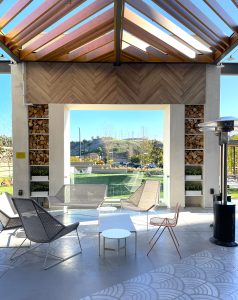
Good Earth Plants used firewood as a biophilic design element at San Diego’s California English restaurant
4. More Natural Materials
Biophilic design elements aren’t just about plants and objects but materials, too. Try bringing a range of natural materials—think tactile options like leather, bamboo, stone and wool. Again, no need to go overboard, but small details like a terra cotta coffee canister or leather catch-all add earthy notes to any room. We’re using more wood in our design elements.
5. Add Objects from Nature
Beach finds like shells, sea glass and drift wood are examples of natural décor that bring a little of the outdoors inside. No matter where you live, small objects abound: dried flowers, pine boughs, even rocks (but don’t go crazy). Any and all bring subtle cues from the wild to your indoor space.
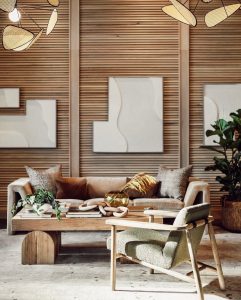
This room designed by Jules Design gets all the light. Plant supplied by Good Earth Plants.
6. More Natural Light
No matter where you live, or how early the sun sets, natural light is always in style. In 2023, though, designers are making it even more of a priority. It’s good for all your indoor plants, it’s good for your circadian rhythm and, when done well, it’s a fantastic design feature that opens rooms up and invites in vitamin D, improves our mood and even inspires joy. Win-win-win. (source: Brick + Decorilla)
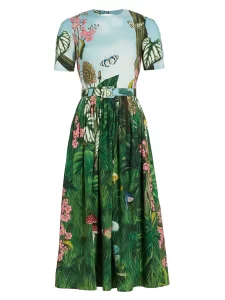
Belted Botanical Dress by Oscar de la Renta
7. Botanical Prints
Pastoral patterns. Bucolic chic. Some call it nostalgia. We call it plain old plant décor. Meant to make you think of your grandma’s house growing up, plant-patterned wallpaper or fabric is making a huge comeback. Stick-on versions can be cost-effective ways to try patterns out before full commitment. Or maybe you’re the bold type who’s ready to dive in and go big on geranium-covered walls or Monsteras in 2-D. If you prefer to wear your nature on your sleeve, adidas and Finnish fashion house Marimekko are on their 4th collab, with even bolder botanic prints on athleisure and gear.
However you update, design and decorate your space this year, biophilic design is an approach that not only looks good, but can improve mind, body and spirit. What’s been your favorite way to experiment so far? Tag us in your designs @goodearthplants

